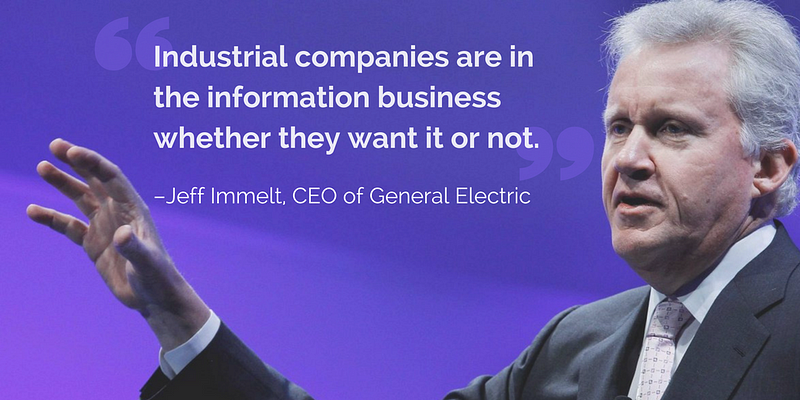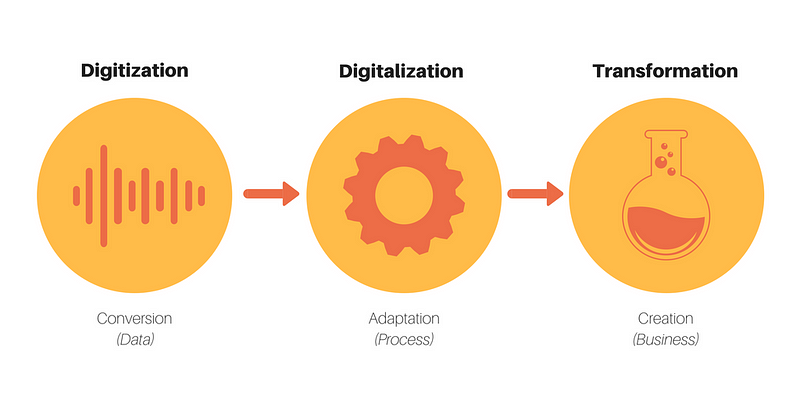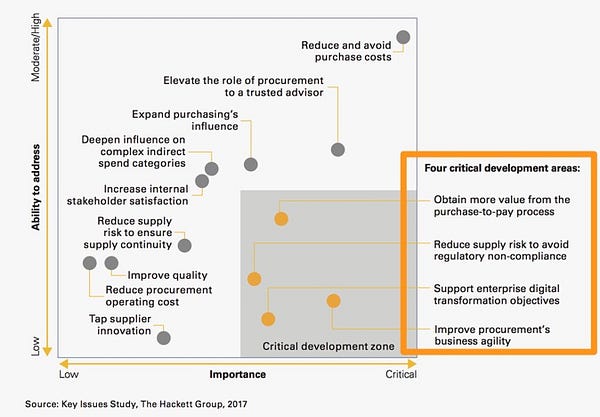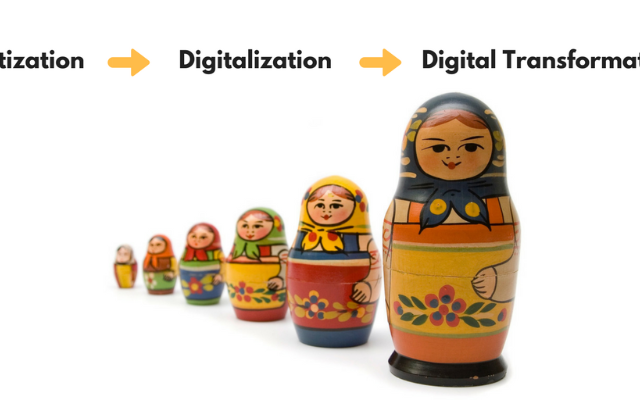The expression “digital transformation“ is becoming an overused buzzword. It is because many use it without a proper understanding of what it actually means. This explains why many organizations are puzzled with regards to how to become digital.
If it was just about using technology…
… then we could consider that most organizations are already there*.
*: if we accept the huge adoption issue of some Procurement technologies.
Electronic tools have been around for a while now. Some are even ubiquitous. So, it would mean that digital transformation is an old story and that most (if not all) organizations are already digital.
But, according to a recent report by The Hackett Group, the situation in Procurement is different:
“84% of procurement organizations believe that digital transformation will fundamentally change the way their services are delivered over the next three to five years. Yet only 32% have developed a strategy for getting there.” 2017 Key Issues Study, The Hackett Group.
As I explained in detail in a previous article (see at the bottom of this page for a link), I believe that many CPOs and Procurement teams are unable to articulate a vision or a strategy because of a misunderstanding of the various words used in the context of “being digital.”
I am talking about digitization, digitalization, and digital transformation. These words are often used in place of each other. The fact that many consider these words as interchangeable reveals the confusion around what digital transformation entails. Hence, the trouble to build a clear vision and an executable strategy. Hence, the reference to “buzzword” in the title of this article.v
Digitization ➜ Digitalization ➜ Digital Transformation

Let’s get to the “definition” of these words:
- Digitization is the conversion from analog to digital. Atoms become bits (e.g. digitization of data). You cannot digitize people.
- Digitalization is the process of using digital technology and the impact it has (e.g. digitalization of a process).
- Digital transformation is a digital-first approach that encompasses all aspects of business, regardless of whether it concerns a digital business or not. It leads to the creation of entirely new markets, customers, and businesses (people, capabilities, processes, operating models,…).
These definitions highlight how these concepts are nested. Digitizing information makes the data easy to access, copy, share, transfer, and process. Using the data is more efficient than when it was analog. The next step is the digitalization of a business process by using technology to improve or transform it with the aim to generate more revenue and / or to reduce costs.
Digital transformation is the broadest of the three terms. Also, there is a significant difference with digitalization. Digitalization is often an incremental improvement or an adaptation of an existing and non-digital process that increases efficiency. Digital transformation is designing new ways of doing things that generate new sources of value. It is more related to effectiveness. Also, it encompasses all of the enterprise, not just a specific process or function.
“Digital business transformation is about doing things differently — creating new business designs by using digital technologies in combination to blur the boundary between the physical and the virtual worlds. It’s not just about automating or inserting technology into an existing process. Nor is it about replacing paper or people.” Gartner
What about the digital transformation of Procurement?

Most of the time, when people talk about the “digital transformation of Procurement,” they speak of digitization or digitalization.
For example, in the P2P process:
- scanning of invoices is a typical example of digitization.
- the use of an eProcurement tool is an example of digitalization.
Also, if we strictly apply the definitions as proposed above, then the expression “digital transformation of Procurement” is erroneous. It is because digital transformation is an enterprise-wide approach and cannot be just about Procurement.
Despite that, Procurement professionals would make a terrible mistake in ignoring what digital transformation means for their practice.

Firstly, Procurement has a particular role to play to support the digital transformation of organizations because it implies new types suppliers with particular digital capabilities and offerings. It is no surprise then that the Hackett Group listed it as one of the four key development areas for CPOs in 2017.
An example that comes to my mind is SKF. SKF is a producer of an “old” technology: ball bearings.
Because of all the progress in sensors, data, and connectivity, they built a digital offering that brings value to them and to their customers who can enrich their offerings (ball bearings are in almost all mechanical assemblies). It is the real purpose of a digital transformation:
- creation of a new revenue stream (for SKF) by offering services on top of their products,
- creation of a platform that empowers customers to build their own digital offering on top of it by integrating the data into a mash-up.
”Every business, no matter how old, has the opportunity and the ability to digitally remaster its products and services.” Mark Raskino & Graham Waller from Gartner in Digital to the Core: Remastering Leadership for Your Industry, Your Enterprise, and Yourself
As the example of SKF demonstrates it, digital transformation is not just for IT companies or the tertiary sector. Many other examples of digital businesses blurring the digital and physical worlds exist. They demonstrate that “if you went to bed last night as an industrial company, you are going to wake up in the morning as a software and analytics company” as Mark Raskino & Graham Waller from Gartner write in their book.
In addition to the Internet of Things (IoT) that the SKF example illustrates, other disruptive and emerging technologies like drones, self-driving cars or trucks, delivery robots, and 3D printing are also transforming supply chains and supplier panels.
They represent an opportunity to create new businesses and to serve customers better by creating:
- a “zero length supply chain”
- mass-customization / “batch size one”
It may still sound like science fiction, but there are already implementations that go beyond the prototype.
The digital revolution is not just for direct procurement. There are many applications in indirect. For example in facility management (FM). Buildings (offices and factories) become smarter thanks to the multitude of sensors installed to manage all aspects of the building (energy management, maintenance, access controls…). It is no longer the Internet of Things but the Internet of Everything! This trend impacts with which suppliers you work and gives FM managers better insights into their activities and potential opportunities for better value. It would also allow FM managers to be in a better position to answer the new needs (mobility, flexibility…) of the workforce that changes the use and design of buildings.
All the changes I mentioned (and there are much more) represent an opportunity for Procurement because it seats between the inside and the outside. It has the best spot to watch markets (internal and external) and detect new approaches and innovations that could be beneficial to their organization.
Secondly, there is a lot to take and learn from the principles and philosophy of digital transformation. The differences in the definitions of digitalization and digital transformation imply a massive change of perspective. Digitalization is mostly about incremental improvement to current ways of doing things. Digital transformation entails a new and fresh look to what is now possible. It is more about creativity than reengineering. Many Procurement organizations are often reluctant to take such a move and to obliterate existing and established processes to think digital-first.
For example, the latest progress in computational power and artificial intelligence (AI) can serve as the foundation for Procurement to finally unlock the benefits of Big Data (as illustrated by the SKF example, one characteristic of digital businesses is to create new services centered on data; data that comes on top of the data that is already available and more traditional). More data brings more context and opens new perspectives in the decision-making process. Analytics can move from being descriptive to predictive and even prescriptive. It can enable Procurement organizations to use the best of “people + machine” and rethink data analysis processes and move to a new model: Cognitive Procurement.

Another central aspect of any digital transformation that Procurement professionals must integrate is the focus on “customer experience” a.k.a. CX. CX represents the application of the “Platinum Rule of Reciprocity.”
Ignoring CX in Procurement would be ignoring:
- the position and role of Procurement connecting the inside and the outside,
- the importance that stakeholders and suppliers (SRM²) have for the existence of Procurement,
- the fact that people, outside of work, are immersed in digital-first experiences all day long,
- the imperative to deliver personalized experiences (Procurement has use supplier segmentations for a long time, but stakeholder segmentations are not that common)
A digital-first example of such new approach is the concept of Procurement assistant I have written about.
By profiting from what new technologies can offer regarding CX, Procurement will be in a better position to win the battle to become supplier / customer / department of choice.
Thirdly, digital transformation is a prerequisite (or enabler) to develop other critical capabilities like the ones highlighted by the Hackett Group:
- Obtain more value in the purchase-to-pay process
- Improve Procurement’s business agility
It is because it would enable Procurement organizations to address the following imperatives (taken from another report from the Hackett Group)
- reallocation of resources from transactional focus to value adding,
- leverage analytics-based decision making,
- re-skill the Procurement function.
Antifragility and VUCA…
Digital Transformation is more than just using a piece of technology. It is a complete overhaul that has far more reaching consequences than what most people think when they speak about digital transformation.
And, even if the expression “digital transformation of Procurement” is, by definition, wrong, it sill makes a lot of sense to use it (as long as you are aware of the abuse of language). It is because it fosters a new perspective / approach to redefining how Procurement operates. The purpose being to make organizations antifragile to prosper in our modern VUCA (Volatile, Unpredictable, Complex and Ambiguous) world.
Article by channel:
Everything you need to know about Digital Transformation
The best articles, news and events direct to your inbox
Read more articles tagged: Featured






